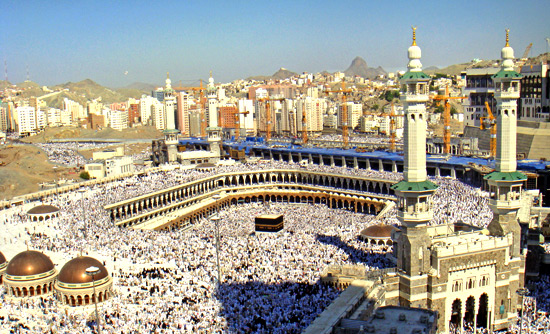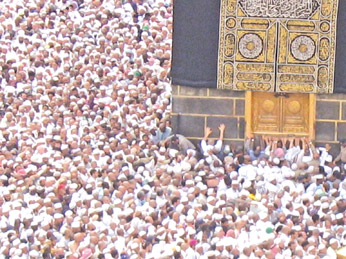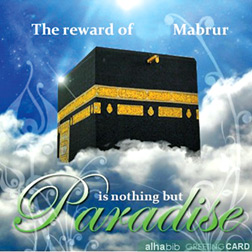Haj bears out significance of unity in Islam
By Mohammed Naalir
Muslims all over the world are getting ready to celebrate the Haj
festival (festival of sacrifice) on Wednesday. Haj is the world’s
biggest annual pilgrimage and Muslims the world over throng the Holy
Makkah (Mecca) to celebrate this event. Thousands of devotees from Sri
Lanka will also take part.
|

Masjid Al-Haram |
Fulfilling Haj is a compulsory duty of every able Muslim at least
once in a lifetime. The money which is spent on Haj should have been
earned in a righteous way. One who goes on this pilgrimage should leave
enough wealth to his family until his return.
Haj portrays the submission to Allah while recalling the yeoman
sacrifice made by Prophet Ibrahim. It pays tribute to the incomparable
sacrifice made by Prophet Ibrahim 1,500 years ago.
Unity is a way of life in Islam and it is practically demonstrated
during the Haj pilgrimage. Islam stresses firstly, the unity of mankind
and secondly, unity among Muslims.
All devotees who throng the Holy Makkah are equal in the presence of
Allah and no one will be discriminated. There is no room for race,
caste, state, rich, poor or colour differences. This is due to the dress
code of Ihram, the only clothing which should be worn by the pilgrims
during the Haj pilgrimage. Sewn garments are prohibited.
The Haj pilgrimage takes place from the seventh to the 13th day of
Dhul-Hijjah, the 12th month of the Islamic calendar. The Islamic
calendar is a lunar calendar and is 11 days shorter than the presently
used Gregorian calendar. According to the Gregorian calendar, the date
of Haj changes every year.
Several obligations
|

Haj pilgrims
|
|

Devotees try to touch the Kaaba |
Several obligations are compulsory during the Haj pilgrimage, one
being walking seven times anti-clockwise around the Kaaba, which is the
focal point and direction to fulfil the five-time prayers.
Kissing the black stone in the corner of Kaaba to wash away previous
sins, running back and forth between the hills of Al-Safa and Al-Marwah
to remind and recall Mother Hajarah, drinking water from the Zamzam
well, going to the plains of Mount Arafat to stand in vigil and throw
stones at Satan are among the rituals which are carried out by pilgrims.
They shave their heads and perform ceremonial animal sacrifices,
another important part of the pilgrimage. Finally, the devotees will
celebrate the three-day global festival.
On the completion or before the completion of the Haj pilgrimage, the
pilgrims will travel to Madinah where several important places connected
with Islamic history and Prophet Muhammad’s life are located. The
pilgrims could, at the very outset, travel to Madinah and visit those
places and thereafter leave to Makkah for Haj or leave for Madinah after
fulfilling the Haj duty first.
Even though it is not a part of the pilgrimage, every Haj devotee
tours Madinah and visits Prophet Muhammad’s mosque, Al-Masjid al-Nabawi
which contains Prophet Muhammad’s tomb and Riaz ul Jannah. The pilgrims
also visit the grave of the Prophet’s companions, Ummahat Ul Momineen
(mothers of Muslims) and Ahle Baith located in Jannat ul Baqi.
As a symbol of unity, Haj pilgrims generally travel in groups. The
Al-Quran stresses the importance of unity and this philosophy is
strongly demonstrated during the Haj pilgrimage.
There are many regulations to be carried out during a Haj pilgrimage.
Pilgrims should wear the Ihram and must not shave. Clipping nails is
prohibited while applying perfume, cursing and quarrelling with one
another must also be avoided. Looking at a woman with desire and having
sexual relations is banned. Uprooting or damaging plants must not be
done. Males should not cover the head while women should not cover the
face while in Ihram.
Before leaving the Holy Makkah, pilgrims should perform a farewell
known as Tawaf Al-Wada. Except the holy words of “Labbaik, Labbaik,
Labbaika Ya Allah! Allahu Akbar!” no other words are heard.
A devotee who fulfilled the Haj in this manner becomes purified from
all previous sins. Haj seems to be a means of purifying oneself from
sins. The devotees will throng the Miqat at the same time to pray, to
ask for forgiveness and celebrate in Allah’s glory together.
Going to Mina
Devotees will go to the neighbouring town of Mina on the day of
Tarwiyah every year. Mina is five kilometres from Makkah, the devotees
must recite the Luhar, Ashar, Maghrib, Isha and the morning Fajr prayer
as Prophet Muhammad did. Next they must pray four Raka’as or shorten it
to two Raka’as.
 After sunset on the ninth day of Dhul-Hijjah, pilgrims must leave for
Muzdalifah, walking in peace, reciting the Talbiyah on their way. They
should not cause inconvenience or injury to fellow pilgrims. After sunset on the ninth day of Dhul-Hijjah, pilgrims must leave for
Muzdalifah, walking in peace, reciting the Talbiyah on their way. They
should not cause inconvenience or injury to fellow pilgrims.
When the devotee reaches Muzdalifah, he must pray combining Maghrib
and Isha, but shorten the Isha to two Raka’as. They would spend the
night sleeping on the ground, under the stars, but women, the elderly
and the infirm may return to Mina after midnight. In the morning of the
10th day of Dhul-Hijjah, devotees must pick up seven pebbles or Jamarah
to throw at the Jamarah Al Aqabah. The pebbles can also be picked up at
Mina.
They return to Makkah for the next essential ritual, Tawaf. Devotees
must walk seven times anti-clockwise around the Kaaba, starting at Al-Hajar
al-Aswad or the Black Stone. They will pray in their own words or repeat
the words “Bismillah wa Allahu akbar” while walking around. They will
touch the fourth corner or the ‘Yemeni Corner’ of the Kaaba each time
they pass by.
Once the seventh round is completed, devotees would stand behind
Maqam-e-Ibrahim or if it is crowded, anywhere within Al-Haram to pray
for two Raka’as.
During the first Raka’a or round, the Surat Al-Kafiroun is recited
and during the second Raka’a, the Surat Al-’Ikhlas is recited. Finally,
they take a drink from Zamzam, as Mother Hajarah and her son Ishmael
did, and pray.
The 11th, 12th and 13th days of Dhul-Hijjah after the Day of
Sacrifice are known as Ayyam-ut-tashreeq. After Saee, the devotees must
return to Mina. Those who wish to leave Mina on the second day must
depart before sunset or spend another night at Mina and take part in the
“stoning the devil” ritual again the next day. The Ramy al-Jamarat
ritual starts in the afternoon of the 11th, 12th and 13th day of Dhul
Hijjah.
Nobody can mourn on this day. Visiting neighbours and relatives on
this holy day is preferable. The Haj festival should be celebrated
within the limits of Islam.
Muslims should refrain from unwarranted activities. Helping the less
fortunate and poor people will add further value to the Haj festival. |

